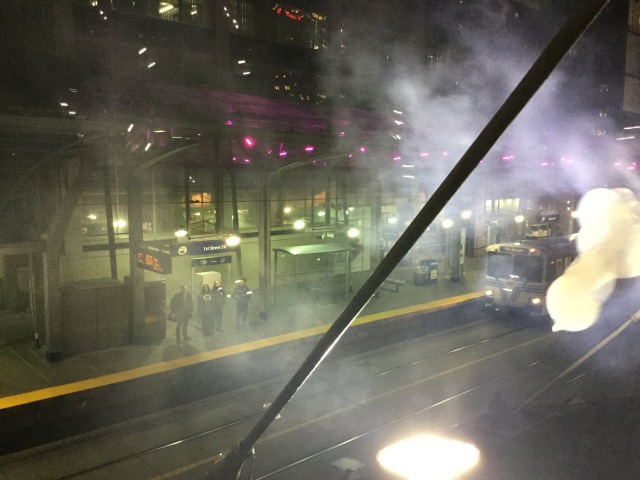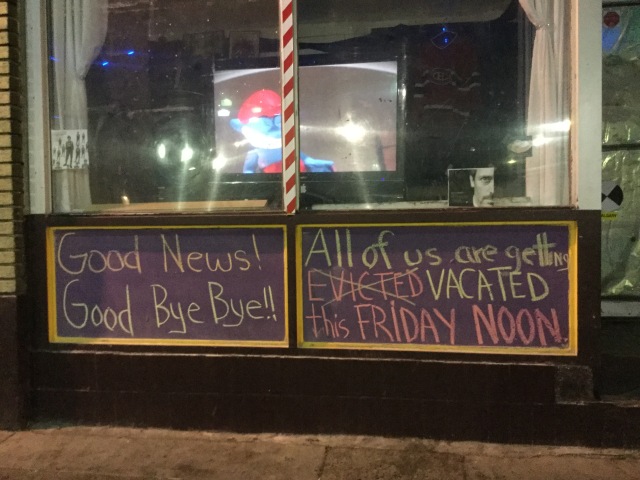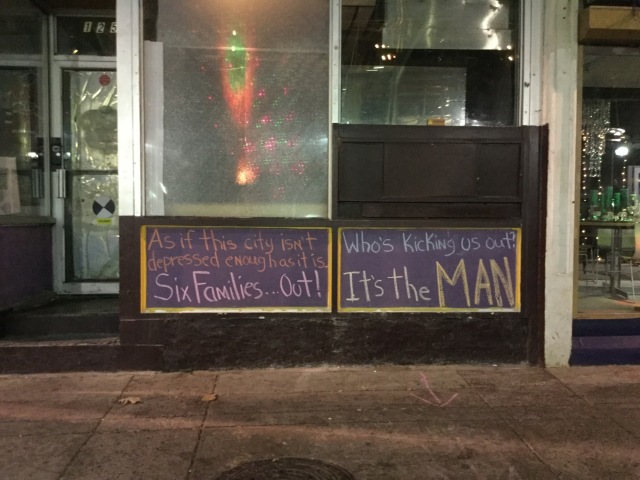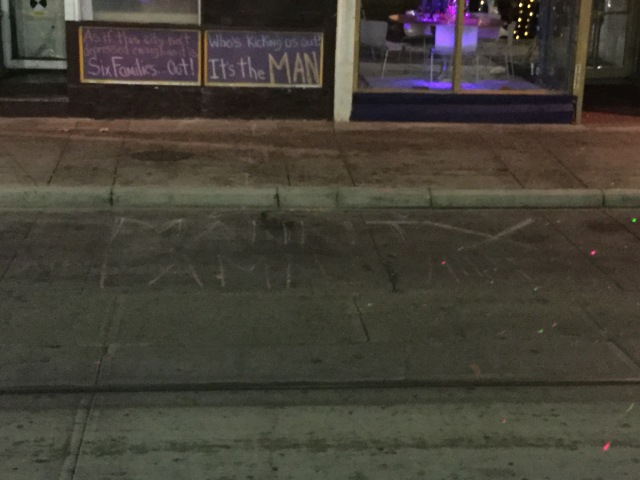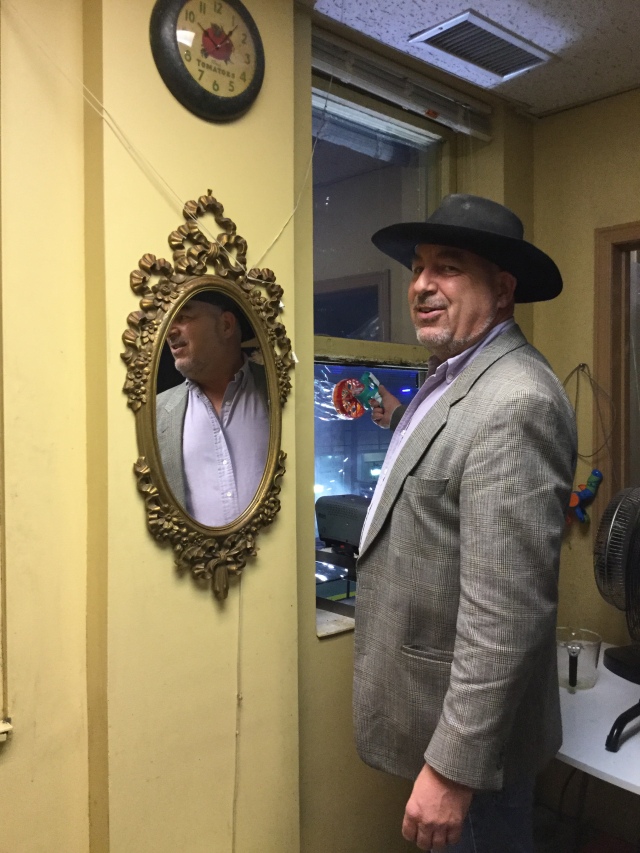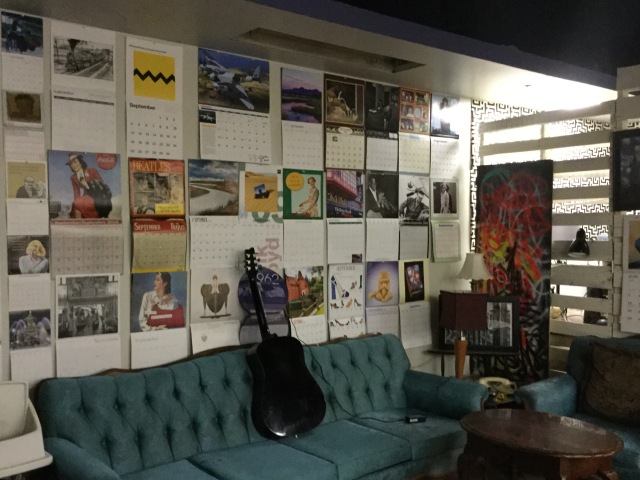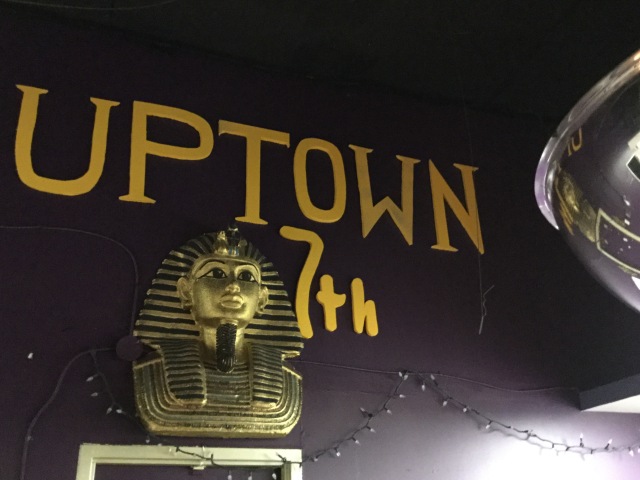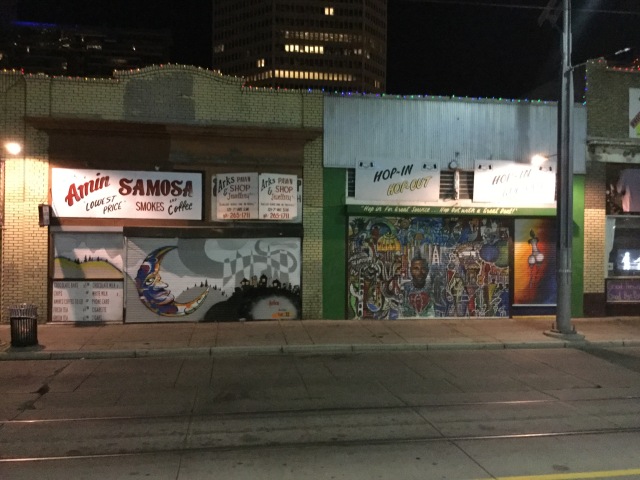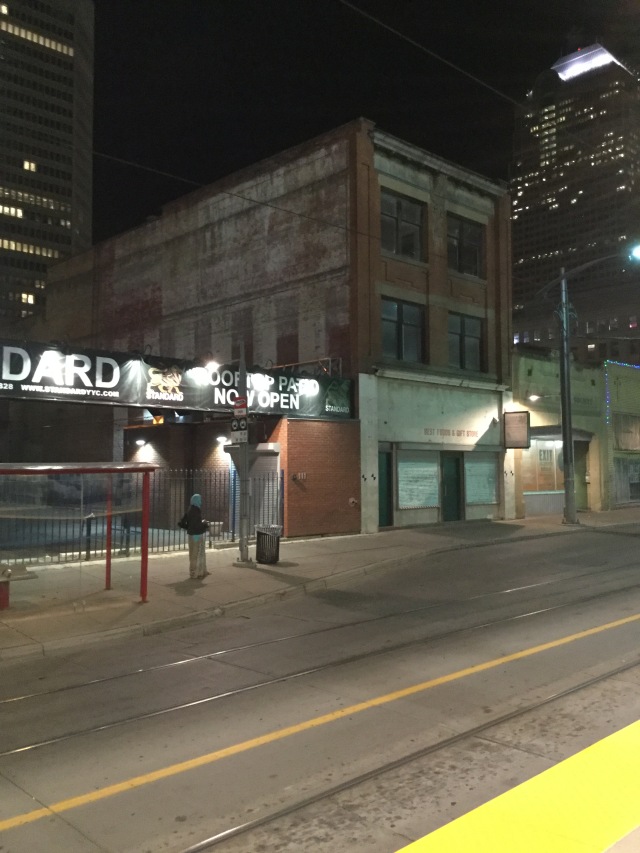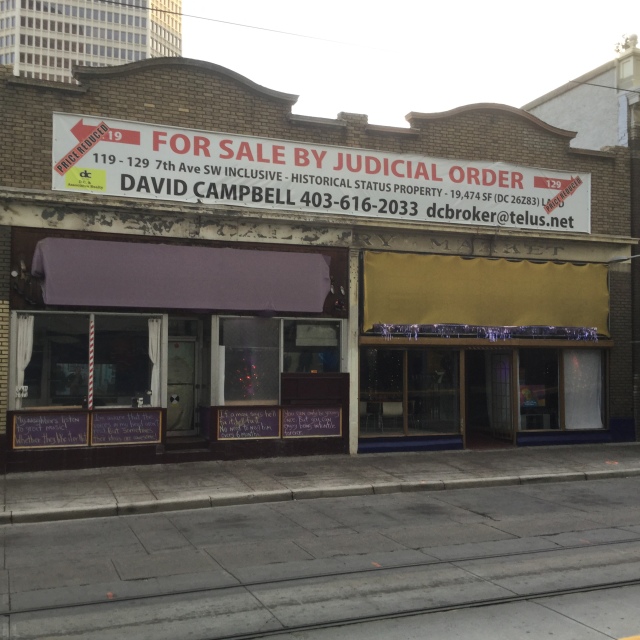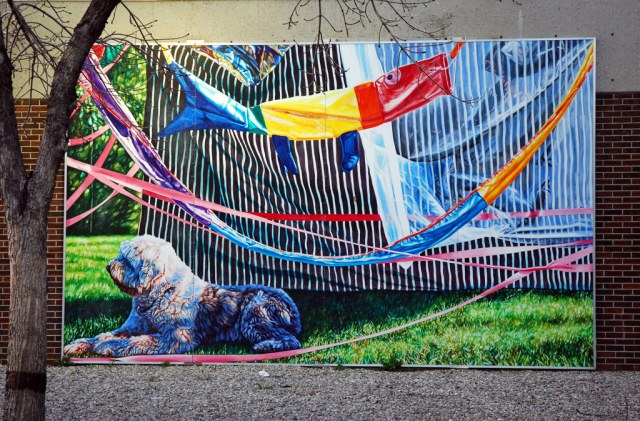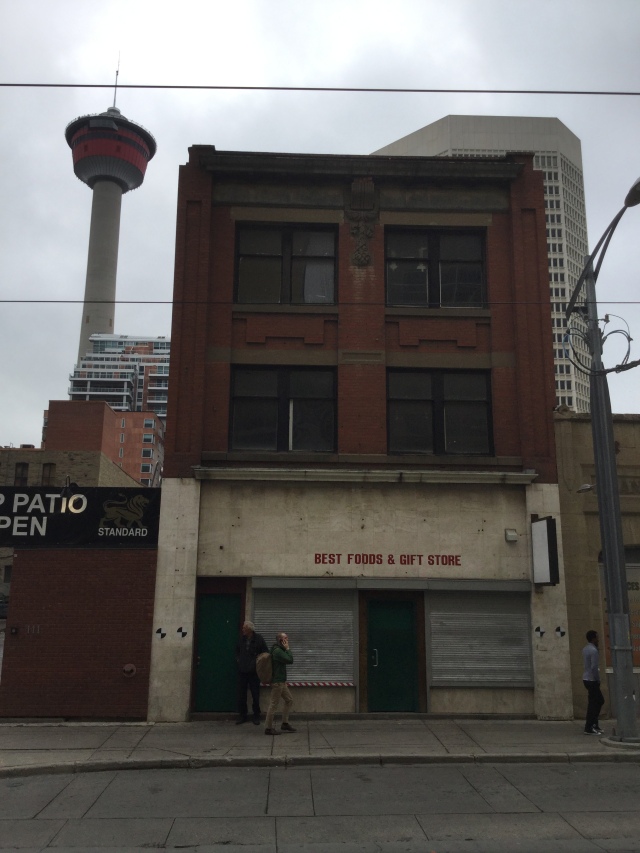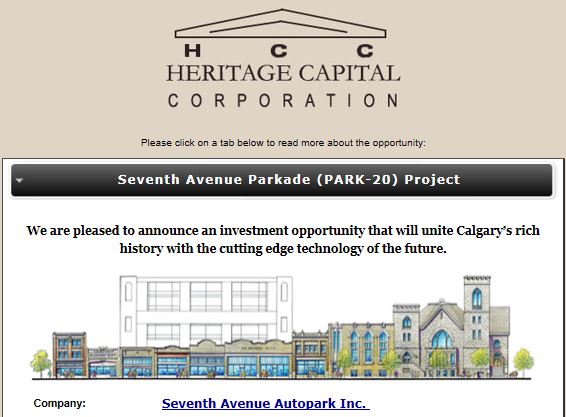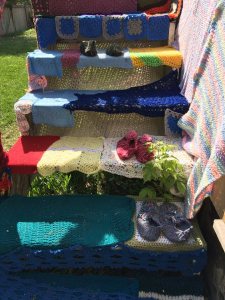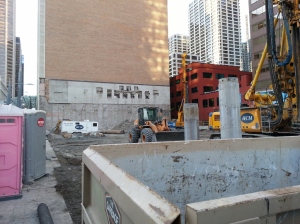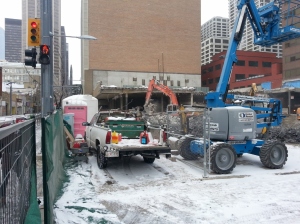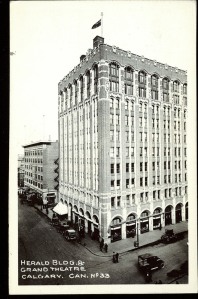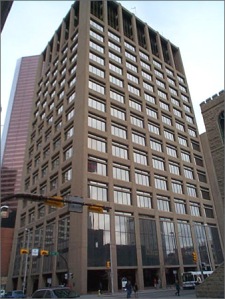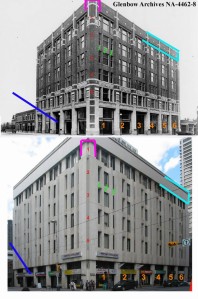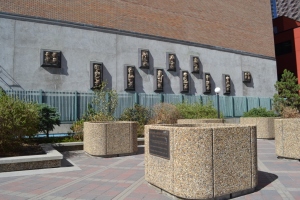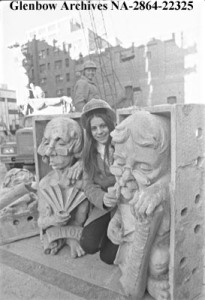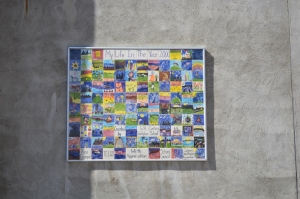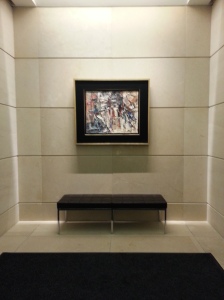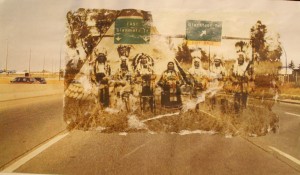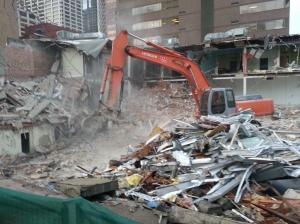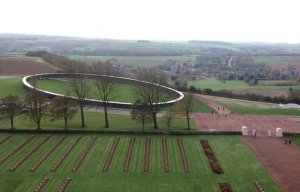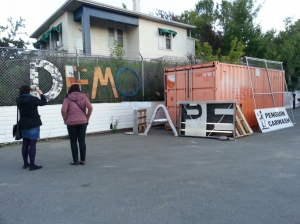
A week ago this past Friday (June 19), I attended the opening evening of the newly opened incarnation of Wreck City. I got there late as the last band was packing up. I was only able to see a few things that evening and had to return to see the remainder the following day. Sadly, even though I began writing this on the second day, this project called Demo Tape has now ended.
The last project that this curatorial team called Wreck City was involved with was entitled Phantom Wing. It occurred in the fall of 2013 and I have written at least one or two posts about it. If you are curious, follow the Phantom Wing link to the right.
Phantom Wing (from what I understand) was under the direction of cSPACE (working in collaboration with the curators of the successful original Wreck City project in Sunnyside). I have written a few things about it during the time that the project was running. It was coordinated to kick off the impending demolition stage of the new wing of the King Edward School that is intended to be an arts incubator.
About a month or two ago, the official sod turning event happened at the King Edward School. Two years later (after Phantom Wing), it would appear as if the King Edward School project has finally began the building stage process. As stated optimistically in the press release above, occupancy is scheduled for mid-2016. But given how long it has taken to get to this stage, and with some knowledge of how long construction projects often take, it is my speculation that occupancy will be more likely occur at some point during 2017. But since I am not involved in this project, it is possible that I could be wrong.
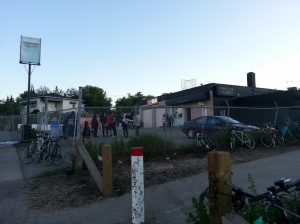
After my little introductory diversion, the curators of Wreck City put the word out in January and in February that they were looking to resurrect the concept once again.
At that stage, they indicated that they were looking for space in the inner city communities. From what I understand there were a number of options that came as a result, which is not surprising given the rapid gentrification and upgrading of older communities in the city. Obviously given that this concept occurred – they found a suitable space.
This event was held in the former Penguin Car Wash overlooking the Elbow River between Fort Calgary and the Esker. It has a fantastic view of downtown Calgary and the mountains behind.
It also has a connection to an art mystery.
Specifically, this mystery involves a series of Rembrandt letters which prove that two recently purchased Rembrandt paintings were indeed forgeries and also involve a murder that was tied to an incident to obtain these letters. Of course, this whole Rembrandt story is a complete fabrication. But it was a small piece of the plot for the movie Silver Streak (1976) featuring Gene Wilder, Jill Clayburgh, Patrick McGoohan and Richard Pryor.
The Penguin Car Wash connection takes place at the bottom of the small hill that the car wash is located upon. The CP railway bridge which crosses the Elbow River and is located directly below the carwash. See next photo, as it is quite possible that this scene was shot from this viewpoint (or nearby).
At the beginning of the third act of Silver Streak, Gene Wilder and Richard Pryor jump from the train into the Elbow River below. I tried to find a clip of the scene, but could not track it down. I guess that means you will have to watch the whole movie instead. It is possible that the Penguin Car Wash is visible in the movie. However, it has been so long since I have seen it, I am uncertain whether it is visible or not. Now I have to track down a copy and view it again as well.
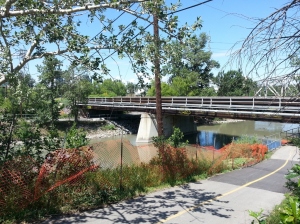
After, yet another diversion, back to the Penguin Car Wash and Wreck City’s Demo Tape.
As stated earlier, I visited opening day toward the end of the night. The band that I heard while waiting for the freight train to pass, was already starting to pack up by the time I arrived. As a result, I only got to see some of the installations. However, I came back the following day when it was less busy and saw the remainder when there were less crowds.
It was interesting, however this version, did not have the same amount of buzz around it that I recall from the first iteration. Why that was, I am unsure. Maybe it was a bit more structured, formalized and probably a bit more thoughtful.
These are all good things, that are to be expected as an organization matures and changes.
Midway through the event, the organizers were forecasting that they would get 5000 attendees. Although the final numbers of those who attended have not been released, based on the following comments, a guesstimate can be made that probably somewhere between 2500 and 3000 people most likely attended. This is a solid attendance for an art event with little media support.



Of course this cannot compare with the approximately 8000+ that attended the original project. We can attribute this variance to any number of reasons, given that both took place over a similar time period. Some of these reasons are:
- Public transit accessibility – original was two blocks from a C-Train platform vs. Demo Tape had little transit infrastructure nearby and about a kilometre away from the nearest C-Train platform.
- Time of year – the original event occurred at the end of university/college school term (last week of April) vs. Demo Tape occurred at the end of primary school term and the beginning of summer holidays for many.
- Cultural awareness – the original event ramped up in the fading days of the year-long Calgary 2012 event when awareness of cultural events was high (with Calgary 2012 receiving seed money and support from organizations such as the federal government’s Department of Heritage, Calgary Arts Development Authority, Calgary Stampede, Calgary Public Library, Calgary Parks and Recreation and others) vs. Demo Tape which depended upon the connection to Sled Island and Wreck City’s own base who attended previous events.
- Number of artists – original had approximately 150 artists vs. Demo Tape which had approximately 50
- Cohabitation – to my recollection the original had more cohabitation happening between artists in the same (this is probably the nature of the more intimate nature of the buildings used, where the spaces were smaller and artwork would cross over perceptually even though they were placed in separate spaces in each house) vs. Demo Tape where each artist had more distinctly separated physical spaces for their artwork and larger spaces in general.
- Newness – the original concept had the perception that it was new (in some ways it was, and for many attendees it was definitely something new. In other important ways it was not. I state this because it was a derivation of a previous project one or more of the curators were involved with a project that occurred in 2011 a few blocks away from the original Wreck City project in the community of West Hillhurst) vs. Demo Tape being the third project by the Wreck City collective after a two-year hiatus.
Were these reasons enough to make a difference?
Maybe. Maybe not.
These will all be factors that the curators will need to figure out when they do their post-event analysis, debriefing and reporting (if they actually do that). Potentially, I am actually doing it for them (or at least giving the curators something to think about).
Audiences can be very fickle and it is hard to determine what the root cause is that will prompt attendance in one case and not the other.
Media
I also have to mention media. Even the news outlets, didn’t get behind this event like they did for the Sunnyside project. During the 10-day run of the project, I believe that only the Calgary Herald actually reported on the project. There also was an interview with a number of the curators on CJSW radio. Both happened on the first day and nothing else happened afterwards.
To be fair, there was certainly coverage leading up to the week leading up to the event, In addition, the media really helped put the word out about the collective’s search for space back in February.
Whatever happened, and why it was not covered as it was previously, I suppose will remain a mystery.
Of course, it is worth mentioning once again, that the visible absence of arts reporting through the vehicle of FastForward Weekly is still noticeable, especially for special events such as this.
This has subsequently made the act of talking about visual arts and exhibitions, somewhat like talking to an audience (that may or may not be there) in a steel drum. I have said it before. I will say it again. Local arts reporting is critically important for an artist’s career and development. It is the same reason why music reporting is important, why theatre coverage is important and sports coverage is important. At the end of the day, they all serve the same type of purpose – to a point.
But, I guess removing visual arts coverage entirely, and/or having said coverage take place from a different geographical location is all done in the name of progress and it is not my call to make. I just try to add my little bit from time to time – and when my own time allows this luxury (since I don’t get paid to write this blog).
The actual event
I must be honest. Although I went, my heart was not overly engaged. The first night I came immediately after work and spent more time talking to people I knew than looking at art. The second day I spent more time relaxing on site and talking to an art teacher who travelled by herself from Madison, Wisconsin to volunteer at the Demo Tape event. I feel bad, because I spent at least an hour or more talking to her – and now I have forgotten her name. She had never visited Canada before, but came with the intent to volunteer, see some scenery, but also to see the two performances of Godspeed You! Black Emperor and a few other groups she wanted to see as part of Sled Island before heading back to Wisconsin. She was a very interesting person to talk to and it was a very enjoyable time.

There were a number of interesting projects, however overall it gave the appearance of a glorified art school project focusing on installation-based work.
This is understandable, due to the nature of the event. So this is not necessarily a criticism. The majority of work was slated to be destroyed along with the building at the end of the actual event. By that very nature, the works will have an unfinished and raw quality to them. As a result, it will rarely be like something one would see in a gallery setting.
That is both the blessing and curse of this type of event. Expectations potentially can be high, when they shouldn’t be. And the reverse is also true.
As mentioned previously, much of this show had much more conceptual bent than was the case with the two previous iterations – Wreck City (the original) and Phantom Wing. I am unsure why this is the case (and it is certainly not an issue), maybe it was partly curatorial; maybe it was the artist’s interests who applied; maybe it was the nature of a long lead time, with limited amount of time with access to the space; maybe it was just delivery (and how it was perceived); or maybe it was a combination thereof. In the end it doesn’t matter.

For me, some of the highlights of this event were (and there were certainly more):
J.D. Mersault’s installation/performance/story entitled Forty-Four Fragments for a Car Wash (see http://fortyfourfragments.tumblr.com/).
At first I did not pay much attention to what was going on, when I saw the artist sitting at a desk writing, since it was the first piece I encountered upon entering the site and wanted to head straight in knowing that I only had a limited amount of time.
However, once I realized that this was part of the exhibition, and the more I looked at this work, and thought about it – the more I found it fascinating. It was a multi-disciplinary piece that was not static, but combined elements of durational performance, installation, memory, poetry and more. I was very intrigued by what he was attempting to do.
Obviously, what I encountered on the first night was a work in progress. What intrigued me was the dialogue that the artist had with two works that I was previously familiar with – 1.) John Scott’s piece Trans Am Apocalypse No. 2 (1993) which is in the collection of the National Gallery of Canada; and 2.) Joan Cardinal Schubert’s The Lesson (1989) which was first shown at Articule Gallery in Montreal.
In Cardinal-Schubert’s work (which was included in the Glenbow’s Made in Calgary: The 1990s large group exhibition. In this Made in Calgary show it was recreated and incorporated as part of that exhibition a little over a year ago. In that installation Cardinal-Schubert installed school desks, chalk boards and other related ephemera as it talked about residential school for aboriginal students. There is an image to her work as installed at the Glenbow in 2014 here. Of course, this is timely given the recent release of the Truth and Reconciliation Commission of Canada Report. It however should be stated that Mersault’s work does not have the same political edge that Cardinal -Schubert’s has.
In John Scott’s piece, the artist transcribed and etched the complete Book of Revelations of St. John the Evangelist into the entire surface of a black Trans Am. In JD Mersault’s piece he was in the process of writing the contents of a new book onto a steel desk. This was intended to cover the surface of the desk in a manner similar to John Scott’s piece mentioned above. I am somewhat disappointed that it was only the top surface, and the not the entirety as in the case with Scott’s Trans Am. But I also understand, that it is a time-exhaustive process with only a limited amount of time – so I cannot be too disappointed. This work was being written during the duration of the Demo Tape event in his position as writer-in-residence – a piece entitled Forty-Four Fragments for a Car Wash (see hotlink above) which he would like to publish at the end of the event. I am very intrigued and curious to see where this work will lead.
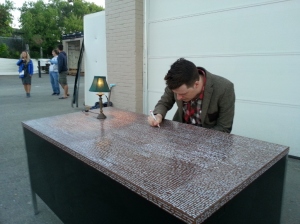
Palmer Olson’s installation My Favourite Buildings. Here the artist deconstructed the office space, catalogued the items; and packed it up. He then attached a packing slip with all the contents of the office listed; provided instructions and renderings, ready for reinstallation elsewhere.
The dialogue involved with this work engaged with the larger concept of gentrification; adaptive re-use of historical spaces; demolition of marginal space; sustainability; and other issues surrounding construction waste as a result of new development (in both greenfield and brownfield areas) which all adds to our landfills.
It is an interesting dialogue to have in the city with all the rapid gentrification (although not to the same extent as was happening even a year ago); and the generally prevailing concept that new is better than old, bigger is better than small.
This dialogue is an important one to have and it lends itself well to this type of project.
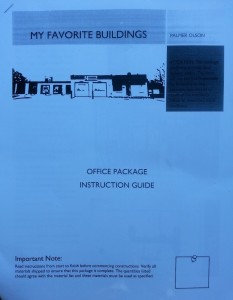
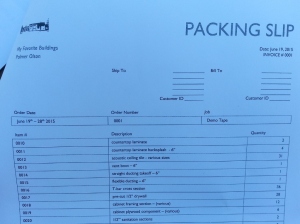
Lane Shordee’s and Desiree Nault’s installation With Sprinkles.
This installation which was located directly beside Palmer Olson’s was a two part installation. I hate to use the word beautiful (and maybe even a bit magical), but sometimes these terms fit.
One of the rooms, presumably an office space of some sort was enclosed and it was possible to only look into it. Above this room was a windmill made from materials salvaged from the car wash. Using this windmill, 24 kg of iridescent confetti was ground up and passed through a hand-made sieve and allowed to descent into the room below like snow. Presumably through wind-currents in the room it created this magical space that had a sense of otherworldliness, but yet at the same time was very familiar. Because the photo was taken quite early on the iridescence is not as visible as it would be toward the end of the 10 days.
When I visited the space earlier today to get a photo of the CP Rail bridge, the windmill was still operational. It is visible in a photo that I took on opening day and have placed near the top of this posting. It is somewhat easy to overlook, but you can see it in the image with bicycles in the front and the building behind. It is on top of the building to the left of the sign that states “The Club is Open”
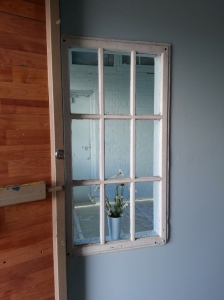
Lane and Desiree’s installation tied in well with another magical space created by Ben Nixon and Rachelle Quinn entitled Perhaps this Sound.
I was fortunate enough to have been asked to leave (along with everyone else at closing time on opening night) as I was just entering the room where this installation was located. I say fortunate, because had I actually visited it, I might otherwise have missed what made the space interesting.
The following day, on Saturday, I was the only one in that room.
As a result, I was able to interact with the keyboard that was part of the installation and play around with it without feeling pressure to move on. The interactive element, and there were other installations that were interactive and interesting such as The Cave were interesting as well, but in that case, I encountered it with lots of people around. Perhaps the Sound installation appealed to me on a more personal level and the other may have been different if I was the only one there. With the immersive music; the ability to control lights and sounds (somewhat, even though the outcomes may be unpredictable); and the immersive nature of the space with multiple senses being activated was a very enjoyable diversion and short-term escape that I enjoyed.
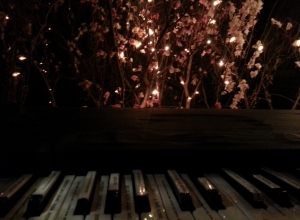
Overall, this iteration was different, and had a more thoughtful feel to it, than was my recollection and perception of the previous two iterations.
* * *
Now that the space is vacant, what is the plan moving forward?
This is something that has not really been talked about to the best of my knowledge.
From sources that I believe to be knowledgeable, the space is slated to be demolished (which is probably common knowledge given the nature of the project).
This is being done to make way for a new residential complex. Unlike most recent constructions of late, this will be built as a rental property. This is potentially an interesting location for a new residential development as recent news has had a fair amount of conversation about the new LRT Green Line expansion.
This all gets back to my initial comments about Gene Wilder and Richard Pryor in the movie Silver Streak in a round-about way. Let me explain.
Recently, the federal government made a $2.6 billion announcement of new federal infrastructure funds for transit infrastructure in Toronto made by the current Prime Minister in Toronto, the day before Wreck City Demo Tape opened. No doubt, as the journalists who penned the Globe and Mail story intoned in the opening paragraph, this was timed to create warm fuzzy feelings amongst the voting electorate in the critically important Toronto battleground for the upcoming federal election in mid-October. Cynically, but also recognizing the nature of electoral politics (it is a fair assumption, that each party running wants to form government, or at least that is the theory. Otherwise, why would they run?). To do so they will each make announcements to entice voters to vote for them. Because of that, I am sure there will be further announcements in the near future that will be equally as transparent.
Currently there are 23 ridings which are currently split almost evenly in terms of representation between the three major federal parties (9 CON, 7 NDP, 7 LPC). From what read as well, the polling for the GTA is very, very tight with only a few percentage points between each party. With the new electoral district redistribution the city of Toronto will get two new ridings (and the province of Ontario as a whole will get half of the 30 new seats), it will make Toronto that much more important, for any political party that wants to form the next government, but I digress. As someone who is very interested in the political process (not so much party politics), and given these facts, to my mind, it made perfect sense that the current government made this new funding announcement in Toronto.
Of course, this prompted Calgary to also get on track (I know, I know – bad pun) to immediately seek it’s share of the newly announced federal transit infrastructure funding for the Green Line expansion and the Green Line North (aka North Central LRT) which is part of the 30-year plan RouteAhead project.
If this expansion moves forward, it will be adjoining or certainly within close proximity to this new residential development. I say this, as my understanding is that the Green Line is proposed to follow (at least in the inner city portion) the current CP Rail line which is located only a few metres from the Demo Tape site (a jumping off site, if you will pardon the lame joke that references the Silver Streak movie).
Of course this new redevelopment may potentially reduce the current view of the downtown core from the Esker Foundation space. This is interesting given the recent Calgary Herald story earlier this month, which talks about the purchase of the former Farmer Jones auto dealership which was located across the side street from the Atlantic Avenue Art Block which houses the Esker to save the view from the gallery.
It is probably doubtful as I have included an image from beside the CP Rail bridge (the Gene Wilder and Richard Pryor jump off site) which shows the Atlantic Avenue Art Block which houses the Esker (the four story building that the rail beside the tracks points to in this photo) and the Demo Tape space (Penguin Car Wash site) to the right of the two trees in the photo below. And ironically the jump-off point is right in the middle of the two.
As with all new higher density developments, it will be interesting to see how the new development changes the nature of the communities of Inglewood and Ramsay.
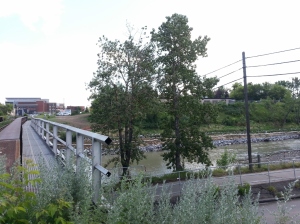
* * *
24 July 2015 @ 12:45MDT edit:
Further to my comments above regarding the GreenLine LRT and RouteAhead expansion, I read with interest that there was a Federal government announcement made this morning with regards tot his project. According to this posting made earlier this morning in the City of Calgary’s news blog, this announcement is the “single largest infrastructure investment in Alberta’s history.” This project will run from the as yet undeveloped community of Keystone Hills in the far north end of the city through to Seton in the deep south which is still undergoing development surrounding the newly established South Calgary medical centre.
